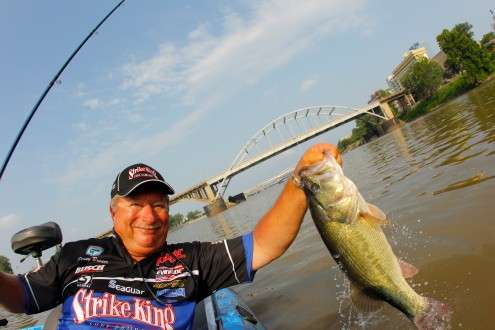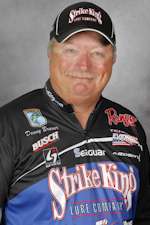
Right after the fall drawdown is a great time to go fishing. You can catch them lots of different ways, but my preference is to flip and pitch whatever isolated cover is still in the water. A recent trip to Kentucky Lake makes my point.
The water was low. Most of what had been in the water was dry. Targets were few and far between, but what was there was strong. That’s typical of fall in a major reservoir. You can think of it like a place where there is a high population of people, but very few houses. Every one of them will be occupied.
The reason for this is simple. Bass pull off the bank as the water drops, but that doesn’t mean they move all the way out to the main drops in deep water. Mostly, they’ll stop at the first thing they can find. That’s usually wood of some sort.
You have to pay attention to find what’s left, however. The best targets are easy to miss. Sometimes it’ll be a larger laydown or maybe even a dock. More often it’ll be a small piece of wood sticking up out of the water. Fish everything no matter how insignificant it looks.
I have two baits that I like to toss when I’m faced with these conditions. The first is a Strike King Rage Tail Craw. You can Texas rig it and put it right against anything that’s in the water. If there’s a clump or a group of stickups — like a treetop — make sure you cover every target from every angle. Despite all you hear about a “fall feeding frenzy,” they can be fickle.
My other choice is a Strike King Premier Pro Model Jig with a Strike King Rage Tail Chunk for a trailer. That’ll do basically the same thing as a Texas rigged Rage Craw except that it’s not as weedless.
My Texas rig weights and my jigs are almost always 3/8 or 1/2 ounce models. I don’t think you should get too technical here. Those two weights will handle almost any situation. My color choices are also simple.
Black and blue is hard to beat anytime. The Rage Craw black/blue flake is a great choice. The Rage Tail Chunk comes in several blue hues. The Premier Pro-Model Jig is available in two versions of black and blue. There’s a standard combination and a black/blue accent where the blue is a little brighter and mostly on the bottom. It’s great for clearer water.
My other choices are browns (Number 49) and Texas Craw. That’s about it for me. There are tons of colors out there, and in a few lakes you’ll need one of them. But for most applications I’ll stick with my three basic colors. I know they’ll bite them. Why change?
I always use matching colors with my trailers or when I put combinations together. I’ve never seen anything in the water that has one color up front and another in the rear. I don’t think the fish have, either.
Next time we’ll talk about line. There are some new choices out there that weren’t available when I first covered the topic in this series. It’s time for an update.





